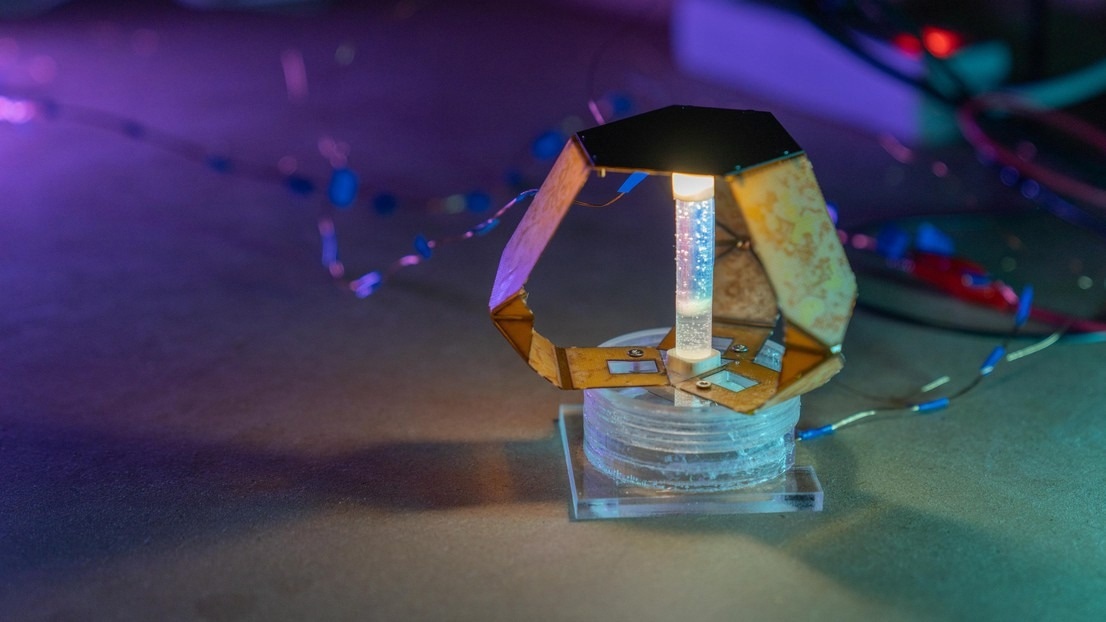
ChromoSense. Image Credit: © Titouan Veuillet/Adrian Alberola Campailla
While robotics researchers have made significant progress in developing sensors that can detect changes in position, pressure, and temperature, there is still a challenge in achieving the ability to sense multiple stimuli simultaneously. Human perception allows to sense multiple stimuli at once, but this has been difficult to replicate in robotics.
Jamie Paik and fellow researchers at the Reconfigurable Robotics Lab (RRL) within EPFL’s School of Engineering have engineered a sensor capable of detecting a blend of bending, stretching, compression, and temperature shifts. Their ingenious system revolves around a straightforward yet robust concept: color.
This new device, called ChromoSense by RRL researchers, uses a translucent rubber cylinder that is divided into three sections, each dyed a different color - red, green, and blue. The device works by using an LED at the top of the cylinder to send light through its core.
As the device is bent or stretched, changes in the light's path through the different colored sections are detected by a miniaturized spectral meter at the bottom of the device. This innovative approach allows ChromoSense to simultaneously sense multiple mechanical and temperature stimuli.
Imagine you are drinking three different flavors of slushie through three different straws at once: the proportion of each flavor you get changes if you bend or twist the straws. This is the same principle that ChromoSense uses: it perceives changes in light traveling through the colored sections as the geometry of those sections deforms.
Jamie Paik, Scientist, School of Engineering, Ecole Polytechnique Fédérale de Lausanne
The device has a thermosensitive section that enables it to detect temperature changes. This is done using a special dye, similar to the one found in color-changing t-shirts or mood rings, that loses its color when it is heated. The research on this device has been published in Nature Communications and has also been selected for the Editor's Highlights page.
A More Streamlined Approach to Wearables
Paik elucidates that while technologies employing cameras or numerous sensing components are effective, they often result in heavier and bulkier wearable devices. Moreover, they necessitate increased data processing, adding to their complexity.
For soft robots to serve us better in our daily lives, they need to be able to sense what we are doing. Traditionally, the fastest and most inexpensive way to do this has been through vision-based systems, which capture all of our activities and then extract the necessary data. ChromoSense allows for more targeted, information-dense readings, and the sensor can be easily embedded into different materials for different tasks.
Jamie Paik, Scientist, School of Engineering, Ecole Polytechnique Fédérale de Lausanne
ChromoSense has a simple mechanical structure and utilizes color instead of cameras, which makes it potentially suitable for mass production at low cost. Paik says beyond assistive technologies like mobility-aiding exosuits, ChromoSense could have everyday applications in athletic gear or clothing. In such applications, the device could be utilized to offer users feedback on their form and movements.
The power of ChromoSense’s capability to identify several stimuli instantaneously – can also be a weakness. Decoupling the applied stimuli simultaneously is still a challenge the scientists are working on. Currently, Paik says, scientists are concentrating on enhancing the technology to sense locally applied forces or the accurate limits of a material when it changes shape.
She says, “If ChromoSense gains popularity and many people want to use it as a general-purpose robotic sensing solution, then I think further increasing the information density of the sensor could become a really interesting challenge.”
In the future, Paik intends to explore various formats for ChromoSense. While currently prototyped in a cylindrical shape and as a component of a wearable soft exosuit, it could potentially take on a flat form, which might be more fitting for integration into the Reconfigurable Robotics Lab's distinctive origami robots.
She summarizes, “With our technology, anything can become a sensor as long as light can pass through it.”
Journal Reference
Baines, R., et al. (2023). Multi-modal deformation and temperature sensing for context-sensitive machines. Nature Communications. doi.org/10.1038/s41467-023-42655-y